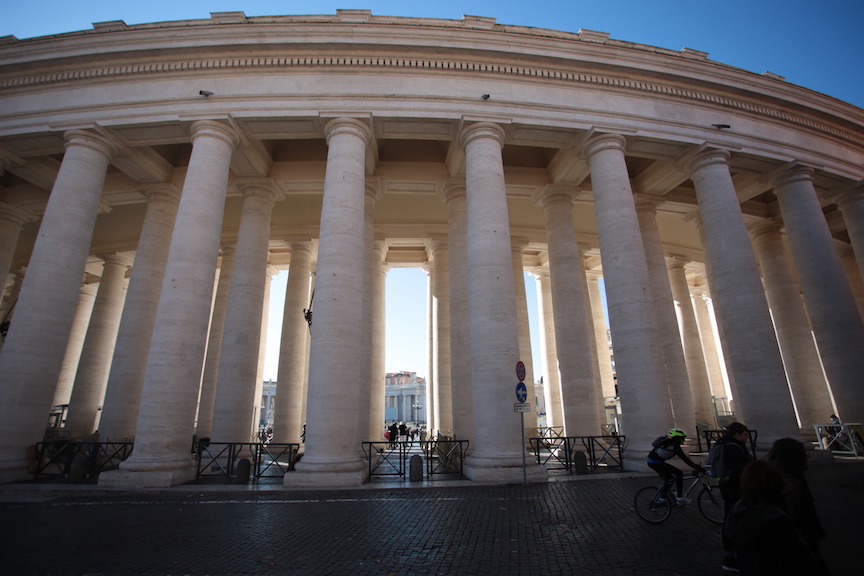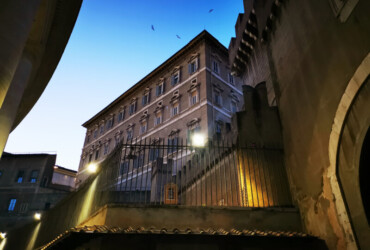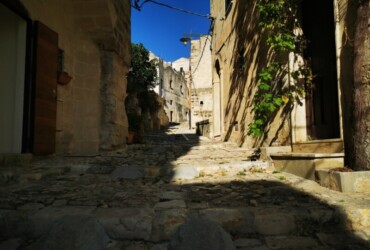Today I want to take you for a ride around an unusual Rome. That Rome from the details “hidden in plain sight”, to be better seen by anyone who passes by and wants to observe the world around him. I was inspired by the book “Unusual and Secret Rome” that I got for my birthday, and for the ride today I take you around the area of the Vatican and Borgo Pio.
 Let’s start with the “White Palazzetto” located in Via di San Fabiano 28, in the Gregorio VII area (therefore, in reality, “on the border” with the Vatican area). The project was born in 1990, from the collaboration between the psychiatrist Massimo Fagioli (creator and designer of the building) and the architect Paola Rossi as a designer. The shape is triangular, decidedly strange and particular and the ideas are decidedly contrasting. Just his strangeness struck me, but I must admit that I have not yet decided whether I like it or
Let’s start with the “White Palazzetto” located in Via di San Fabiano 28, in the Gregorio VII area (therefore, in reality, “on the border” with the Vatican area). The project was born in 1990, from the collaboration between the psychiatrist Massimo Fagioli (creator and designer of the building) and the architect Paola Rossi as a designer. The shape is triangular, decidedly strange and particular and the ideas are decidedly contrasting. Just his strangeness struck me, but I must admit that I have not yet decided whether I like it or
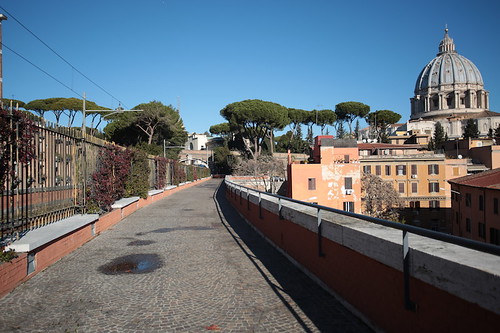 not. The next stop is the papal railway which, on balance, is the shortest international railway in the world. 1270 meters long, it was built according to the Lateran Treaties (1929) to connect the Holy See to the Italian railroad. It was completed in 1932, and the Gelsomino Viaduct was also built: this pedestrian path, only 143 meters long, allows tourists who pass through here to have a spectacular view of the dome of San Pietro. The engine that opens and closes the gate that separates the Vatican from Italy is the original one, and it seems that it still works very well. [NB: initially there were two train tracks, but one was removed during the renovation works at the Roma San Pietro railway station for the 2000 Jubilee].
not. The next stop is the papal railway which, on balance, is the shortest international railway in the world. 1270 meters long, it was built according to the Lateran Treaties (1929) to connect the Holy See to the Italian railroad. It was completed in 1932, and the Gelsomino Viaduct was also built: this pedestrian path, only 143 meters long, allows tourists who pass through here to have a spectacular view of the dome of San Pietro. The engine that opens and closes the gate that separates the Vatican from Italy is the original one, and it seems that it still works very well. [NB: initially there were two train tracks, but one was removed during the renovation works at the Roma San Pietro railway station for the 2000 Jubilee].
 Now we move to Piazza San Pietro, where there is a Meridian: this is one of the longest in the world and starts from under the obelisk (on the right looking at the Basilica) to get past the Fountain of Maderno, almost at the edge of the square itself. Made of granite, at the two ends two marble discs indicate where, at noon, the shadow of the cross falls on the days of the summer solstice (sign of Cancer) and the winter solstice
Now we move to Piazza San Pietro, where there is a Meridian: this is one of the longest in the world and starts from under the obelisk (on the right looking at the Basilica) to get past the Fountain of Maderno, almost at the edge of the square itself. Made of granite, at the two ends two marble discs indicate where, at noon, the shadow of the cross falls on the days of the summer solstice (sign of Cancer) and the winter solstice
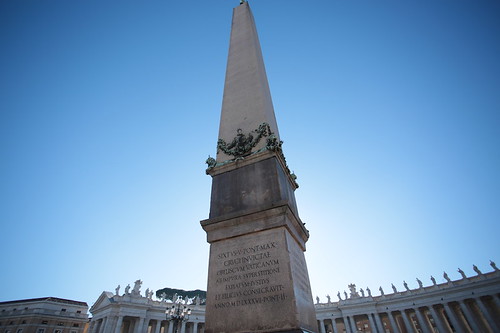 (sign of Capricorn). Obviously, there are also discs that indicate the passage of the sun even in all the other zodiacal signs. The gnomon of the sundial is the gigantic obelisk of the square: made up of a single block of granite 25 meters high (40 with base and cross) and is, according to the book, the only obelisk of Rome that has never collapsed. Its original position was on the side of the Basilica and was moved in 1586 by Domenico Fontana, at the request of Pope Sixtus V.
(sign of Capricorn). Obviously, there are also discs that indicate the passage of the sun even in all the other zodiacal signs. The gnomon of the sundial is the gigantic obelisk of the square: made up of a single block of granite 25 meters high (40 with base and cross) and is, according to the book, the only obelisk of Rome that has never collapsed. Its original position was on the side of the Basilica and was moved in 1586 by Domenico Fontana, at the request of Pope Sixtus V.
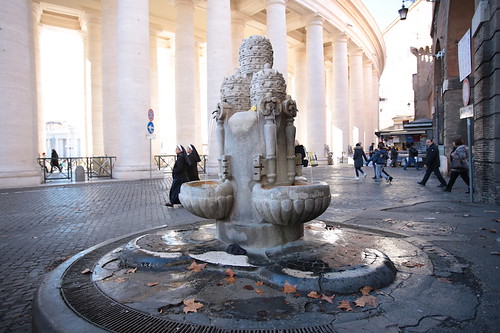 In Borgo Pio, just outside the colonnade of San Pietro (in Largo del Colonnato), there is the Fountain of the Three Tiaras (I am sure that you know it), designed by architect Pietro Lombardi in 1927. The three tiaras they represent the equivalent of the triple tiara (or triregno): it is the crown that the pope receives during the inauguration ceremony that starts the (new) papacy. It is an ornament that has no liturgical value, it is worn only in case of papal processions or solemn juridical acts, and the last Pope
In Borgo Pio, just outside the colonnade of San Pietro (in Largo del Colonnato), there is the Fountain of the Three Tiaras (I am sure that you know it), designed by architect Pietro Lombardi in 1927. The three tiaras they represent the equivalent of the triple tiara (or triregno): it is the crown that the pope receives during the inauguration ceremony that starts the (new) papacy. It is an ornament that has no liturgical value, it is worn only in case of papal processions or solemn juridical acts, and the last Pope
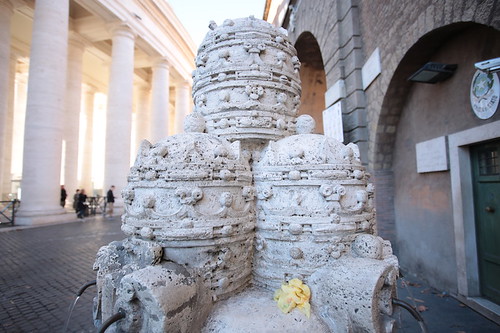 to wear it was Paul VI in 1963, and his successors rarely wore it. Together with the keys tied with a cord, the triple tiara is still one of the leading symbols of the papacy. The keys are a further symbol of the Pope because Jesus gave St. Peter two keys: one of gold (celestial) and the other of silver (terrestrial), representing the ability to open and close the gates of Paradise.
to wear it was Paul VI in 1963, and his successors rarely wore it. Together with the keys tied with a cord, the triple tiara is still one of the leading symbols of the papacy. The keys are a further symbol of the Pope because Jesus gave St. Peter two keys: one of gold (celestial) and the other of silver (terrestrial), representing the ability to open and close the gates of Paradise.
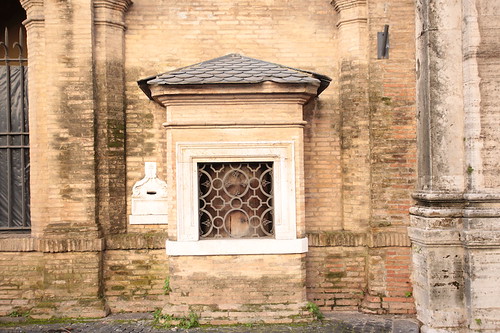 I conclude my post with the wheel of the innocent, which is on the right side of the complex of Santo Spirito in Sassia inside a small house with a grating in front of the wheel itself. The first wheel was commissioned by Pope Innocent III in 1198 to put an end to the practice of children’s abandonment. All the women who gave birth and did not want to keep the baby could leave them in the wheel anonymously. Before the invention of these wheels the practice of “oblation” was widespread: the woman who did not want to keep the child “gave” it to a convent that, in turn, offered hospitality and a future monastic life [NB: this practice wasn’t as abandonment]. In the second half of the nineteenth century, there were about 1200! Their abolition started in 1867 and ended when, in 1923, a regulation was approved by the Mussolini government.
I conclude my post with the wheel of the innocent, which is on the right side of the complex of Santo Spirito in Sassia inside a small house with a grating in front of the wheel itself. The first wheel was commissioned by Pope Innocent III in 1198 to put an end to the practice of children’s abandonment. All the women who gave birth and did not want to keep the baby could leave them in the wheel anonymously. Before the invention of these wheels the practice of “oblation” was widespread: the woman who did not want to keep the child “gave” it to a convent that, in turn, offered hospitality and a future monastic life [NB: this practice wasn’t as abandonment]. In the second half of the nineteenth century, there were about 1200! Their abolition started in 1867 and ended when, in 1923, a regulation was approved by the Mussolini government.
Vatican City and its surroundings – Unusual Rome
